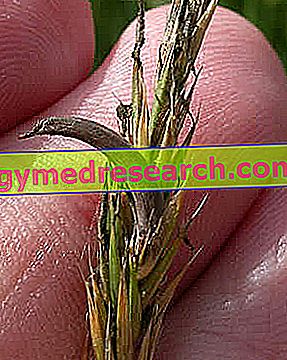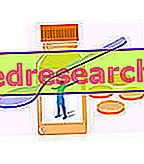Generality
The term "ergotism" is used to indicate a particular type of intoxication caused by excessive (intentional or accidental) consumption of alkaloids deriving from the sclerotium of the fungus Claviceps purpurea (also known as ergot).

Ergotism is also known as ergotoxicosis, ergot poisoning, evil of the ardent, sacred fire and fire of St. Anthony (a name that was attributed to him in the Middle Ages, but which today is used more than anything else to define a particular type of infection viral supported by Herpes zoster ).
History
As mentioned, ergotism is an intoxication known since the Middle Ages. In fact, in this period there were several epidemics of ergotism caused by the ingestion of flours contaminated by Claviceps purpurea .
Ergotism was known by different names, such as sacred fire, fire of the ardent and fire of St. Anthony. In particular, this last name seems to be rooted in the fact that the individuals affected by this intoxication were treated by the monks of the order of St. Anthony, even if the hypotheses made in this regard are different.
However, at the time, ergotism was often lethal intoxication, which could lead to the outbreak of real epidemics, since the link between the consumption of ergot and the manifestations of this poisoning was not known.
Ergotism, in addition to giving rise to physical manifestations, often also caused psychic symptoms, such as hallucinations. For this reason, this "disease" - of which the triggering causes were unknown - was often associated with evil forces, witchcraft and the devil.
It was only hundreds of years later - more precisely, in 1853 - that the reproductive cycle of the Claviceps purpurea was identified and described by the French botanist Louis René Tulasme, shedding a definitive light on the causes triggering ergotism.
Causes
As stated above, ergotism is an ergot alkaloid intoxication, which can be caused substantially in two ways:
- By taking medicines based on ergot alkaloids or its derivatives (in fact, some ergot alkaloids and their synthetic or semisynthetic derivatives are used in therapy for the treatment of different types of disorders, among which we remember the headaches and the migraines);
- Through the intake of flours - or other foods derived from them - contaminated by ergot sclerotia that contain, precisely, the alkaloids responsible for the symptoms of ergotism.
Ergotism epidemics are usually due to the consumption of food contaminated by the fungus in question.
Symptoms and Forms of Ergotism
Before proceeding to the description of the symptoms caused by ergotism, it should be pointed out that this intoxication can manifest itself in two different forms:
- Ergotism in gangrenous form;
- Ergotism in convulsive or neurological form.
Ergotism in gangrenous form
The gangrenous form of ergotism is characterized by a vasoconstriction, made precisely by the alkaloids of the ergot and which mainly affects the peripheral areas of the body, such as the fingers and toes. Such vasoconstriction, if not properly and promptly treated, can lead to gangrene of the affected extremities, therefore to gangrene of hands and feet.
However, the main symptoms that can manifest themselves in the gangrenous form of ergotism are: scaling and dryness of the skin, edema, loss of peripheral sensitivity, necrosis and decomposition (gangrene) of the tissues affected by vasoconstriction. This symptomatology, sometimes, can be preceded by other symptoms, like pallor of the skin and lowering of the temperature of the hands and feet, pain, tingling, weakness and inflammation of the extremities, and formation of blisters.
Ergotism in convulsive or neurological form
The neurological form of ergotism, on the other hand, is characterized by the appearance of symptoms, such as: painful convulsions and spasms, paresthesia, hallucinations, mania, psychosis and headache. Usually, these effects are preceded by gastrointestinal symptoms such as nausea, vomiting and diarrhea.
Treatment
When the diagnosis of ergotism is made, the first step is to stop taking the medicine or food that is believed to have given rise to intoxication.
Unfortunately, there is no real specific cure for the treatment of ergotism; therefore, the patient who presents this intoxication will be hospitalized, where the doctor will treat the symptoms that it manifests (symptomatic treatment).
First of all, we will try to restore the correct circulation through the administration of vasodilator drugs. If the patient also has seizure disorders, then the doctor may decide to proceed with the administration of anticonvulsant drugs.
The other symptoms, psychiatric and otherwise, will also be treated in a similar manner.
Furthermore, in case of acute poisoning with ergot alkaloids, in some cases it could be useful to perform a gastric lavage, or the administration of emetic drugs.
In any case, this type of decision is up to the doctor, who will evaluate what to do on a case by case basis.
In no case, however, should self-diagnosis and self-therapy of ergotism be used; therefore, if ergot alkaloid poisoning is suspected, contact your doctor immediately and contact your nearest hospital.
Prevention
The best therapeutic strategy to combat ergotism is prevention.
Currently, thanks to the strict controls carried out on cereals destined for human consumption (in fact, the ergot can also contaminate cereals other than rye) and their derivatives, food poisoning, and therefore epidemics of ergotism, are decidedly rare events.
Regarding the intake of drugs based on ergot alkaloids, however, when they are prescribed, the doctor should be careful to inform patients of the risks associated with their use. The doctor should then instruct these same patients to make a responsible use of these drugs, advising them to use them only at the recommended dosages and only when really necessary, in such a way as to avert the possible occurrence of side effects (even serious) of any kind, including ergotism.



